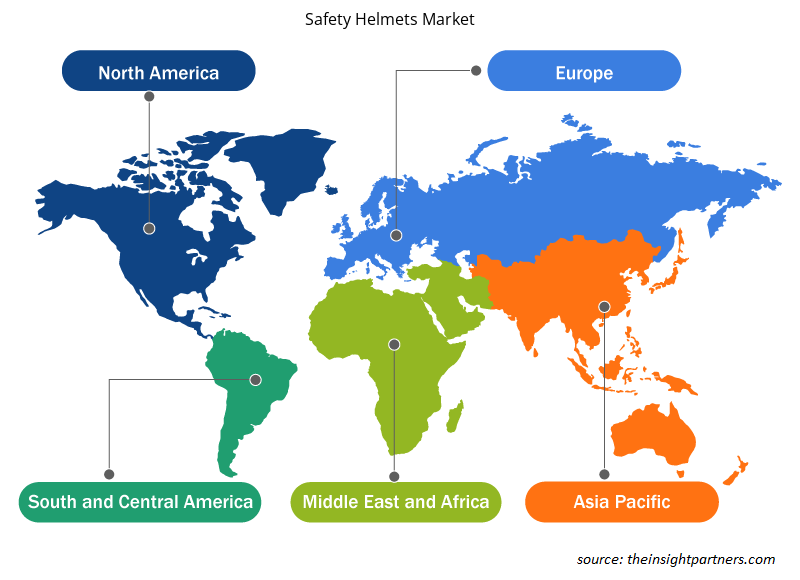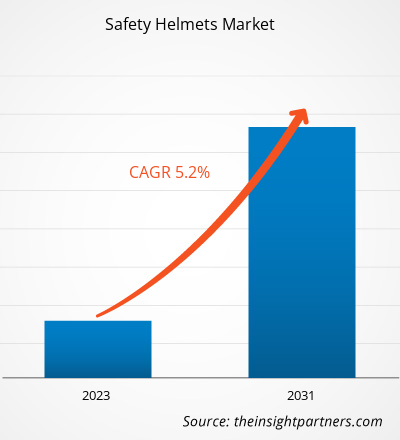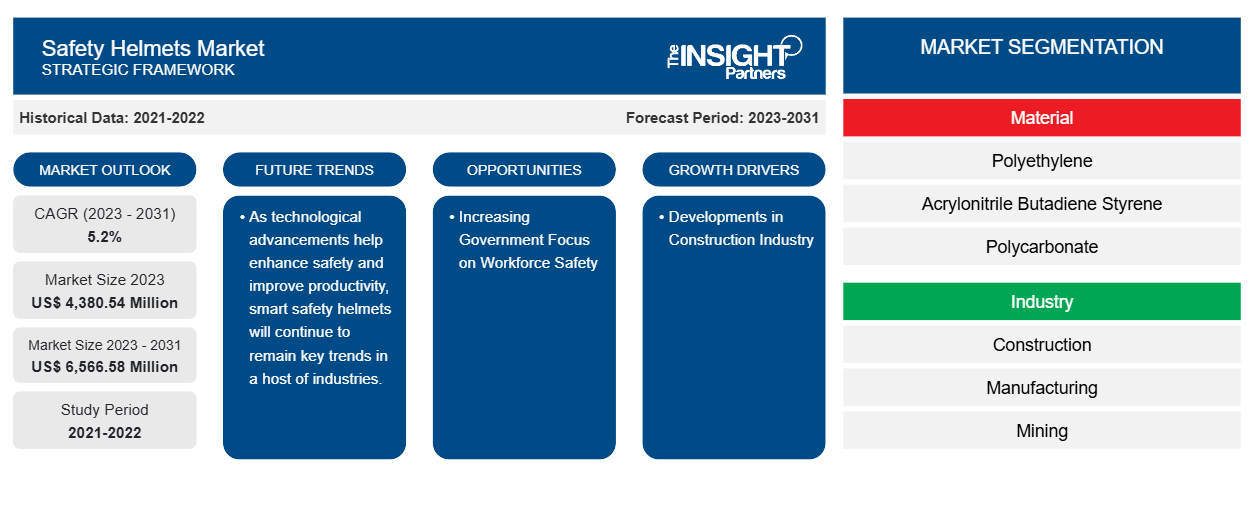Si prevede che il mercato dei caschi di sicurezza raggiungerà i 6.566,58 milioni di dollari entro il 2031, rispetto ai 4.380,54 milioni di dollari del 2023. Si prevede che il mercato registrerà un CAGR del 5,2% nel periodo 2023-2031. Poiché i progressi tecnologici contribuiscono a migliorare la sicurezza e la produttività, i caschi di sicurezza intelligenti continueranno a essere tendenze chiave in una serie di settori.
Analisi del mercato dei caschi di sicurezza
Le industrie ad alta intensità di manodopera impongono l'incorporazione di misure di sicurezza adeguate per la forza lavoro per mitigare il livello di rischi; se ignorate, possono portare a varie situazioni pericolose che possono avere un impatto sulla tempistica complessiva del progetto e sull'efficienza operativa. Pertanto, le misure di sicurezza sono altamente enfatizzate per evitare qualsiasi sfida indesiderata relativa alla salute e alla sicurezza della forza lavoro.
La crescente urbanizzazione e l'aumento della popolazione promuovono la crescita del settore edile, che di conseguenza ha un impatto positivo sul mercato dei caschi di sicurezza. I crescenti progressi nel settore petrolifero e del gas per alimentare la produzione di petrolio e gli scavi minerari e il crescente numero di parchi eolici per la produzione di energia guidano anche l'espansione del mercato dei caschi di sicurezza.
Panoramica del mercato dei caschi di sicurezza
L'accettazione dei caschi di sicurezza si è intensificata nel corso degli anni come una necessità di base per la protezione della forza lavoro. Le industrie che richiedono ai lavoratori di lavorare in quota o in ambienti ad alto rischio stanno spingendo la domanda di caschi di sicurezza a livello globale. Allo stesso modo, le industrie minerarie e delle telecomunicazioni investono una quantità sostanziale in misure di sicurezza, che, a loro volta, accelerano la necessità di caschi di sicurezza. Le crescenti iniziative governative e l'integrazione di rigide normative per incorporare elevati standard di misure di sicurezza della forza lavoro sono altri importanti motori di crescita del mercato dei caschi di sicurezza a livello globale. Le prospettive del mercato dei caschi di sicurezza continuano a essere positive poiché questi caschi sono ben posizionati per soddisfare i requisiti di sicurezza di settori di utenti finali come edilizia, produzione, petrolio e gas, servizi di pubblica utilità, telecomunicazioni e estrazione mineraria.
Personalizza questo report in base alle tue esigenze
Riceverai la personalizzazione gratuita di qualsiasi report, comprese parti di questo report, o analisi a livello nazionale, pacchetto dati Excel, oltre a usufruire di grandi offerte e sconti per start-up e università
-
Scopri le principali tendenze di mercato in questo rapporto.Questo campione GRATUITO includerà analisi di dati che spaziano dalle tendenze di mercato alle stime e alle previsioni.
Driver e opportunità del mercato dei caschi di sicurezza
Sviluppi nel settore delle costruzioni
Con l'espansione e l'evoluzione del settore edile, il requisito di un funzionamento sicuro diventa cruciale. C'è un aumento di vari tipi di progetti di sviluppo infrastrutturale, come complessi commerciali, edifici residenziali e strutture industriali. Ogni progetto necessita di una forza lavoro per la costruzione, la riparazione, la manutenzione e la ristrutturazione. La rapida urbanizzazione e l'esplosione demografica determinano la necessità di nuove abitazioni, spazi commerciali e infrastrutture. Ad esempio, si prevede che l'Arabia Saudita diventerà uno dei più grandi cantieri edili al mondo, con circa ~US$ 1,1 trilioni di investimenti in progetti infrastrutturali e immobiliari. Questi progetti di sviluppo infrastrutturale e immobiliare includono King Salman Park, Neom Super City, Diriyah Gate, The Red Sea Projects e Jeddah Central e Jeddah Economic City Projects.
Con lo sviluppo delle città, la costruzione di grattacieli e progetti su larga scala richiede misure di sicurezza per una costruzione sicura ed efficiente. Progetti unici con progetti architettonici impegnativi o requisiti specifici richiedono misure di sicurezza personalizzate. Ad esempio, a marzo 2023, il consiglio comunale canadese di Kelowna ha dichiarato l'autorizzazione al finanziamento di 90 milioni di dollari USA per il progetto di ampliamento del terminal dell'aeroporto di Kelowna. Inoltre, nel 2022, il governo indiano ha avviato i suoi progetti per costruire 220 aeroporti entro la fine del 2025. Il crescente sviluppo delle infrastrutture e il progresso immobiliare, inclusi progetti commerciali, residenziali e ad uso misto, guidano la domanda di strumenti di sicurezza, inclusi i caschi, durante le attività di costruzione e manutenzione.
Maggiore attenzione del governo alla sicurezza della forza lavoro
I crescenti casi di incidenti sul lavoro sono uno dei principali fattori che ostacolano il regolare funzionamento di qualsiasi progetto di costruzione. Si prevede che la corretta gestione della forza lavoro e la crescente adozione di misure di sicurezza standard per prevenire incidenti sul posto di lavoro favoriranno il mercato dei caschi di sicurezza a livello globale. I governi di diverse nazioni si stanno concentrando molto sulle normative sulla sicurezza della forza lavoro per evitare incidenti. L'Occupational Safety and Health Act del 1970 ha menzionato standard e condizioni di lavoro adeguati per garantire la sicurezza della forza lavoro. L'Health and Safety Executive (HSE), The Health and Safety at Work Act 1974, descrive anche le misure per prevenire infortuni, malattie e decessi correlati al lavoro. In India, la sicurezza sul posto di lavoro è gestita principalmente dal Factories Act (1948) e dal Mines Act (1952). Inoltre, numerose altre leggi, politiche, regolamenti e linee guida sono correlate a settori e industrie specializzate. Pertanto, si prevede che le crescenti iniziative governative e l'introduzione di rigide normative per proteggere le misure di sicurezza della forza lavoro offriranno opportunità redditizie per il mercato dei caschi di sicurezza durante il periodo di previsione.
Analisi della segmentazione del rapporto di mercato sui caschi di sicurezza
I segmenti chiave che hanno contribuito alla derivazione dell'analisi di mercato dei caschi di sicurezza sono i materiali e il settore.
- In base al materiale, il mercato dei caschi di sicurezza è segmentato in polietilene, acrilonitrile butadiene stirene, policarbonato e altri. Tra questi, il polietilene ha detenuto la quota maggiore nel 2023, a causa della sua crescente domanda nel crescente settore delle costruzioni.
- In termini di settore, il mercato è suddiviso in edilizia , produzione, estrazione mineraria e altri. Tra questi, il settore edile ha acquisito la quota maggiore nel 2023 a causa della significativa domanda di caschi di sicurezza nei progetti di costruzione residenziali e commerciali in tutto il mondo.
Analisi della quota di mercato dei caschi di sicurezza per area geografica
L'ambito geografico del rapporto sul mercato dei caschi di sicurezza è suddiviso principalmente in cinque regioni: Nord America, Asia Pacifico, Europa, Medio Oriente e Africa, Sud e Centro America.
L'Asia Pacific ha dominato il mercato dei caschi di sicurezza nel 2023; continuerà a dominare il mercato durante il periodo di previsione a causa di fattori quali i crescenti sviluppi nel settore delle costruzioni, la crescente attenzione del governo allo sviluppo delle infrastrutture, la crescente domanda di lavori di ristrutturazione e riparazione e la rapida urbanizzazione. Cina, India e Giappone occupano posizioni di rilievo nel mercato dei caschi di sicurezza nell'Asia Pacifica.
Approfondimenti regionali sul mercato dei caschi di sicurezza
Le tendenze regionali e i fattori che influenzano il mercato dei caschi di sicurezza durante il periodo di previsione sono stati ampiamente spiegati dagli analisti di Insight Partners. Questa sezione discute anche i segmenti e la geografia del mercato dei caschi di sicurezza in Nord America, Europa, Asia Pacifico, Medio Oriente e Africa e Sud e Centro America.

- Ottieni i dati specifici regionali per il mercato dei caschi di sicurezza
Ambito del rapporto di mercato sui caschi di sicurezza
| Attributo del report | Dettagli |
|---|---|
| Dimensioni del mercato nel 2023 | 4.380,54 milioni di dollari USA |
| Dimensioni del mercato entro il 2031 | 6.566,58 milioni di dollari USA |
| CAGR globale (2023-2031) | 5,2% |
| Dati storici | 2021-2022 |
| Periodo di previsione | 2023-2031 |
| Segmenti coperti |
Per materiale
|
| Regioni e Paesi coperti |
America del Nord
|
| Leader di mercato e profili aziendali chiave |
|
Densità degli attori del mercato dei caschi di sicurezza: comprendere il suo impatto sulle dinamiche aziendali
Il mercato dei caschi di sicurezza sta crescendo rapidamente, spinto dalla crescente domanda degli utenti finali dovuta a fattori quali l'evoluzione delle preferenze dei consumatori, i progressi tecnologici e una maggiore consapevolezza dei vantaggi del prodotto. Con l'aumento della domanda, le aziende stanno ampliando le loro offerte, innovando per soddisfare le esigenze dei consumatori e capitalizzando sulle tendenze emergenti, il che alimenta ulteriormente la crescita del mercato.
La densità degli operatori di mercato si riferisce alla distribuzione di aziende o società che operano in un particolare mercato o settore. Indica quanti concorrenti (operatori di mercato) sono presenti in un dato spazio di mercato in relazione alle sue dimensioni o al valore di mercato totale.
Le principali aziende che operano nel mercato dei caschi di sicurezza sono:
- 3M Società
- Honeywell International Inc
- MSA Sicurezza Inc.
- Prodotti di sicurezza Centurion Ltd
- Concord Helmet & Safety Products Private Limited
- JSP limitata
Disclaimer : le aziende elencate sopra non sono classificate secondo un ordine particolare.

- Ottieni una panoramica dei principali attori del mercato dei caschi di sicurezza
Notizie di mercato e sviluppi recenti sui caschi di sicurezza
Il mercato dei caschi di sicurezza viene valutato raccogliendo dati qualitativi e quantitativi dopo la ricerca primaria e secondaria, che include importanti pubblicazioni aziendali, dati di associazioni e database. Di seguito sono elencati alcuni degli sviluppi nel mercato dei caschi di sicurezza:
- STUDSON, uno sviluppatore di caschi di sicurezza che ha recentemente lanciato il primo casco di sicurezza Full Brim ANSI Type II, unico nel suo genere, ha annunciato il completamento di un round di finanziamenti da 2,48 milioni di dollari USA e una collaborazione strategica con Blaklader, uno dei maggiori produttori di indumenti da lavoro in Europa. (Fonte: STUDSON, comunicato stampa aziendale, marzo 2024)
- Lakeland Industries, Inc. (NASDAQ:LAKE) (la "Società" o "Lakeland"), produttore leader mondiale di indumenti protettivi per l'industria, l'assistenza sanitaria e i soccorritori a livello federale, statale e locale, ha annunciato oggi l'acquisizione di Pacific Helmets NZ Limited ("Pacific") con sede in Nuova Zelanda in una transazione interamente in contanti del valore di circa 8,5 milioni di dollari, soggetta ad adeguamenti post-chiusura e consuete disposizioni di ritenuta. (Fonte: STUDSON, Comunicato stampa aziendale, novembre 2023)
Copertura e risultati del rapporto sul mercato dei caschi di sicurezza
Il rapporto "Dimensioni e previsioni del mercato dei caschi di sicurezza (2021-2031)" fornisce un'analisi dettagliata del mercato che copre le seguenti aree:
- Dimensioni e previsioni del mercato dei caschi di sicurezza a livello globale, regionale e nazionale per tutti i principali segmenti di mercato coperti dall'ambito
- Tendenze del mercato dei caschi di sicurezza e dinamiche di mercato come conducenti, sistemi di ritenuta e opportunità chiave
- Analisi PEST e SWOT dettagliate
- Analisi di mercato dei caschi di sicurezza che copre le principali tendenze del mercato, il quadro globale e regionale, i principali attori, le normative e i recenti sviluppi del mercato
- Analisi del panorama industriale e della concorrenza che copre la concentrazione del mercato, l'analisi della mappa di calore, i principali attori e gli sviluppi recenti nel mercato dei caschi di sicurezza
- Profili aziendali dettagliati
- Analisi storica (2 anni), anno base, previsione (7 anni) con CAGR
- Analisi PEST e SWOT
- Valore/volume delle dimensioni del mercato - Globale, Regionale, Nazionale
- Industria e panorama competitivo
- Set di dati Excel
Report recenti
Rapporti correlati
Testimonianze
Motivo dell'acquisto
- Processo decisionale informato
- Comprensione delle dinamiche di mercato
- Analisi competitiva
- Analisi dei clienti
- Previsioni di mercato
- Mitigazione del rischio
- Pianificazione strategica
- Giustificazione degli investimenti
- Identificazione dei mercati emergenti
- Miglioramento delle strategie di marketing
- Aumento dell'efficienza operativa
- Allineamento alle tendenze normative























 Ottieni un campione gratuito per - Mercato dei caschi di sicurezza
Ottieni un campione gratuito per - Mercato dei caschi di sicurezza